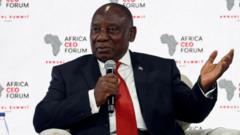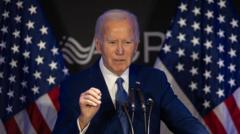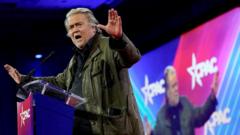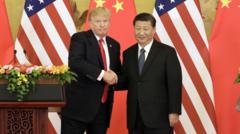As the 2024 election approaches, Kamala Harris's and Donald Trump's contrasting appeal highlights the profound impact of gender perceptions on voter behavior.**
Gender Dynamics Shape 2024 Presidential Election Landscape**

Gender Dynamics Shape 2024 Presidential Election Landscape**
The gender gap in U.S. elections ignites debates as Kamala Harris and Donald Trump navigate complex social changes.**
In the lead-up to the 2024 U.S. presidential election, the gender divide among voters is becoming increasingly pronounced. While polls indicate that men largely favor Donald Trump, women show a strong preference for Kamala Harris, fueling discussions about the underlying factors driving these preferences.
Kamala Harris stands as a historic figure in this election, being the first woman of color to secure a major party presidential nomination. In her recent interviews, she has emphasized her qualifications over her identity, asserting her capacity to lead all Americans, irrespective of gender or race. Despite her intentions to downplay identity politics, the stark reality is that gender has emerged as a pivotal theme this election.
Critics assert that “hidden sexism” influences voter perceptions, with some individuals hesitant to candidly express their discomfort with the idea of a woman president. Instead, they might articulate concerns regarding Harris’s readiness or capabilities, veiling deeper biases. Trump’s campaign counters by focusing on Harris's character and policies, claiming that concerns about her candidacy stem from her perceived weakness rather than her gender.
Reflecting on previous elections, figures like Congresswoman Madeleine Dean recall similar sentiments during Hillary Clinton's campaign, recognizing how gender biases shaped voter attitudes. Although certain societal changes have taken place since 2016, the idea of a powerful woman still evokes ambivalence for some voters.
The #MeToo movement has markedly raised awareness about gender discrimination and professional female leadership. But for some young men, these advancements feel like a threat, prompting feelings of alienation and frustration. Polling expert John Della Volpe indicates that this demographic often feels marginalized, leading some to gravitate toward figures like Trump, who appeal to traditional masculine identities.
As Trump promotes a robust masculine narrative in his campaign, he capitalizes on the discomfort some men feel in today’s shifting cultural landscape. His appeals resonate powerfully with those who perceive themselves as sidelined in the ongoing discourse about gender equity.
In contrast, the Democratic response aims to encourage traditional male support for female leadership, with notable figures advocating for it directly. The stark contrast between the campaigns reflects not just a battle of candidates but a broader social referendum on gender roles today.
With new polls indicating Trump’s advantage among male voters, while Harris leads female demographics, it’s clear that the outcome of the election hinges upon these gender dynamics. As candidates navigate these complexities, the American public’s reception of gender and leadership continues to evolve, marking this election as a critical moment in the fight for gender equality and representation.
Kamala Harris stands as a historic figure in this election, being the first woman of color to secure a major party presidential nomination. In her recent interviews, she has emphasized her qualifications over her identity, asserting her capacity to lead all Americans, irrespective of gender or race. Despite her intentions to downplay identity politics, the stark reality is that gender has emerged as a pivotal theme this election.
Critics assert that “hidden sexism” influences voter perceptions, with some individuals hesitant to candidly express their discomfort with the idea of a woman president. Instead, they might articulate concerns regarding Harris’s readiness or capabilities, veiling deeper biases. Trump’s campaign counters by focusing on Harris's character and policies, claiming that concerns about her candidacy stem from her perceived weakness rather than her gender.
Reflecting on previous elections, figures like Congresswoman Madeleine Dean recall similar sentiments during Hillary Clinton's campaign, recognizing how gender biases shaped voter attitudes. Although certain societal changes have taken place since 2016, the idea of a powerful woman still evokes ambivalence for some voters.
The #MeToo movement has markedly raised awareness about gender discrimination and professional female leadership. But for some young men, these advancements feel like a threat, prompting feelings of alienation and frustration. Polling expert John Della Volpe indicates that this demographic often feels marginalized, leading some to gravitate toward figures like Trump, who appeal to traditional masculine identities.
As Trump promotes a robust masculine narrative in his campaign, he capitalizes on the discomfort some men feel in today’s shifting cultural landscape. His appeals resonate powerfully with those who perceive themselves as sidelined in the ongoing discourse about gender equity.
In contrast, the Democratic response aims to encourage traditional male support for female leadership, with notable figures advocating for it directly. The stark contrast between the campaigns reflects not just a battle of candidates but a broader social referendum on gender roles today.
With new polls indicating Trump’s advantage among male voters, while Harris leads female demographics, it’s clear that the outcome of the election hinges upon these gender dynamics. As candidates navigate these complexities, the American public’s reception of gender and leadership continues to evolve, marking this election as a critical moment in the fight for gender equality and representation.




















